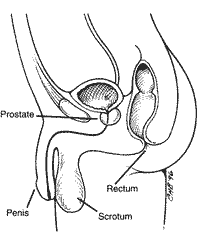|

 Prostate
enlargement (otherwise known as benign prostatic hyperplasia,
or BPH) is one of the most common health problems faced
by men over age forty. In fact, about 50 percent of
men will
experience prostate problems in their sixties, a number
that grows to about 80 percent of men by the time
they
reach their eighties. So if you are experiencing symptoms
of an enlarged prostate, you're not alone. Prostate
enlargement (otherwise known as benign prostatic hyperplasia,
or BPH) is one of the most common health problems faced
by men over age forty. In fact, about 50 percent of
men will
experience prostate problems in their sixties, a number
that grows to about 80 percent of men by the time
they
reach their eighties. So if you are experiencing symptoms
of an enlarged prostate, you're not alone.
What is the prostate and where
is it?
The prostate is a gland located just below the bladder
and in front of the rectum. It wraps around a tube called
the urethra, which carries urine and semen, the white
fluid that contains sperm.
How an enlarged prostate affects
you
Prostate enlargement usually starts at the innermost
part of the prostate, the part closest to the urethra.
As the prostate grows, it gradually begins to squeeze
the urethra, like a clamp on a garden hose. Urination
becomes more difficult, and the bladder may not be able
to empty completely, keeping small amounts of urine
behind. This combination of blocked urethra and irritated
bladder, if left untreated, can lead to more serious
problems including infection and damage to the kidneys
and bladder.
Basic Facts
- Enlarged
prostate, or benign prostatic hyperplasia, is a
condition which eventually affects 80 percent of
all men.
- The main
problem from an enlarged prostate is difficulty
in urination, which may lead to blockage and infection
and have a negative impact on the person's quality
of life.
- There
are many treatment options for an enlarged prostate,
including new minimally invasive therapies that
can be an alternative to traditional surgery.
- It rarely
occurs in men before age 40, and is most common
in men after age 60.
- Enlarged
prostate is not prostate cancer, and is not life-threatening
in and of itself.
- Early
diagnosis is the key to successful treatment.
All
men over the age of 50 should have a regular prostate
exam. Men of African-American descent, those
with
a family history of prostate cancer, or those with
no knowledge of family history (adopted), should
begin regular screenings at age 40.
Symptoms
Most symptoms of an enlarged prostate involve urination,
and they can range from mild to bothersome to severe,
when a man isn't able to urinate at all. It's important
to check with your doctor as soon as you notice anything
unusual with regards to urination. The symptoms of an
enlarged prostate may vary, but "typical"
symptoms include:
- Weak urine stream
- Nighttime urination
- Urgent urination
- Starting and stopping
of urination
|
- Interference with
sexual activity
- Hesitancy of stream
- Frequent urination
- Sensation of incomplete
bladder emptying
- Painful or burning
urination
|
Often, the severity of symptoms is related to how constricted
the urethra is by the prostate. Without treatment, these
symptoms may continue to worsen as the condition progresses.
Treatment
You don't have to endure the symptoms of
BPH. Prostate enlargement is treatable. Your options
range from medication, office-based or outpatient
procedures to traditional surgery. Each treatment has
advantages
and disadvantages,
and all medical procedure have potential risks and
complications. You should talk to your doctor about
all of your options.
Medication
Medication is usually the first treatment for BPH.
There are several medicines that relieve the symptoms
in most
men, at least initially. For some, medication loses
its effectiveness over time or causes undesirable
side
effects such as dizziness, low blood pressure or impotence.
Because BPH symptoms return when the medication
is stopped, even those who find continued relief without
side effects are faced with the lifelong expense and
inconvenience of a daily medication regimen; thus,
many seek longer-lasting solutions.
Surgery
The most traditional long term treatment is surgery,
which cuts away the enlarged prostate tissue. Transurethral
Resection of the Prostate (TURP) is the most common
BPH surgery. It involves inserting an instrument in
the urethra and removing excess prostate tissue one
piece at a time. Another surgical option, open prostatectomy,
requires an abdominal incision and is therefore typically
reserved for severely enlarged prostates.
These traditional surgeries generally require a one
to three-day hospital stay. Both surgeries can provide
long-term relief, but they can also produce serious
long-term side effects such as incontinence, difficulty
attaining erections and ejaculation problems.
Advanced Technology
In an effort to deliver long-term relief with fewer
risks and side effects than traditional surgery, medical
scientists have developed and refined other BPH treatments
in recent decades. These treatments use advanced technology,
such as lasers, microwaves, or radio frequency, to
reduce the size of the prostate without actually cutting
it.
These less invasive outpatient procedures are frequently
recommended as alternatives to medication or when
medication
fails. They usually cannot be performed if BPH has
progressed to a severe stage and are not generally
recommended
for patients with poor bladder function.

Notice: Information on this web site is provided for informational
purposes only and is not a substitute for professional medical advice. You
should not use the information on this web site for diagnosing or treating
a medical or health condition. If you have or suspect you have a medical
problem, promptly contact your professional healthcare provider.
|
|



